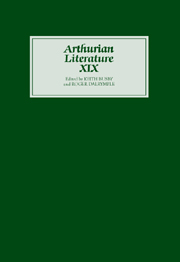Book contents
- Frontmatter
- Contents
- General Editor's Foreword
- I Comedy and Tragedy in Some Arthurian Recognition Scenes
- II Merveilleux et comique dans les romans arthuriens français (XIIe–XVe siècles)
- III La bande dessinée virtuelle du lion d'Yvain: sur le sens de l'humour de Chrétien de Troyes
- IV Convention, Comedy and the Form of La Vengeance Raguidel
- V Le comique dans Les Merveilles de Rigomer et Hunbaut
- VI Humour in the Roman de Silence
- VII La pratique de la ‘disconvenance’ comique dans le Lancelot en prose: les mésaventures amoureuses de Guerrehet
- VIII Lancelot Part 3
- IX Comic Functions of the Parrot as Minstrel in Le Chevalier du Papegau
- X Dinadan en Italie
- XI A Comical Villain: Arthur's Seneschal in a Section of the Middle Dutch Lancelot Compilation
- XII Malory and the English Comic Tradition
- XIII ‘Laughyng and Smylyng’: Comic Modalities in Malory's Tale of Sir Launcelot du Lake
- XIV The Eachtra an Amadáin Mhóir as a Response to the Perceval of Chrétien de Troyes
- CONTENTS OF PREVIOUS VOLUMES
VIII - Lancelot Part 3
Published online by Cambridge University Press: 05 February 2013
- Frontmatter
- Contents
- General Editor's Foreword
- I Comedy and Tragedy in Some Arthurian Recognition Scenes
- II Merveilleux et comique dans les romans arthuriens français (XIIe–XVe siècles)
- III La bande dessinée virtuelle du lion d'Yvain: sur le sens de l'humour de Chrétien de Troyes
- IV Convention, Comedy and the Form of La Vengeance Raguidel
- V Le comique dans Les Merveilles de Rigomer et Hunbaut
- VI Humour in the Roman de Silence
- VII La pratique de la ‘disconvenance’ comique dans le Lancelot en prose: les mésaventures amoureuses de Guerrehet
- VIII Lancelot Part 3
- IX Comic Functions of the Parrot as Minstrel in Le Chevalier du Papegau
- X Dinadan en Italie
- XI A Comical Villain: Arthur's Seneschal in a Section of the Middle Dutch Lancelot Compilation
- XII Malory and the English Comic Tradition
- XIII ‘Laughyng and Smylyng’: Comic Modalities in Malory's Tale of Sir Launcelot du Lake
- XIV The Eachtra an Amadáin Mhóir as a Response to the Perceval of Chrétien de Troyes
- CONTENTS OF PREVIOUS VOLUMES
Summary
It is amazing how little is known with any amount of certainty about the actual making of the prose Lancelot and the Vulgate Cycle. In this article some issues will be raised concerning the cycle's genesis, especially with regard to the making of the Lancelot from the prose Charrette onwards.
Jean Frappier dates the composition of the Vulgate Cycle between 1215 and 1235 and describes it as a process of composition and growth, under the supervision of an architect. He compares it to the building of a cathedral. The narrative develops in phases: from just Lancelot's tale to a trilogy with the Queste del Saint Graal and Mort le roi Artu, and from there to a fivefold cycle: Estoire dou Saint Graal – Estoire de Merlin plus Suite-Vulgate du Merlin – Lancelot – Queste – Mort Artu.
A chronological survey of the manuscript tradition, however, reveals no sequence of manuscripts dating from the first half of the thirteenth century that demonstrates the growth from one to five texts. The chronological diagram in the appendix shows that, in fact, one of the oldest manuscripts – Rennes 255 – already has the Estoire dou Saint Graal and Estoire de Merlin, which are generally considered later additions. The Lancelot–Queste–Mort Artu trilogy does exist separately in at least eight manuscripts, and in the diagram this configuration is predominant in the upper quarter (from the top to the Bonn 526 manuscript).
- Type
- Chapter
- Information
- Arthurian Literature XIXComedy in Arthurian Literature, pp. 117 - 134Publisher: Boydell & BrewerPrint publication year: 2002



